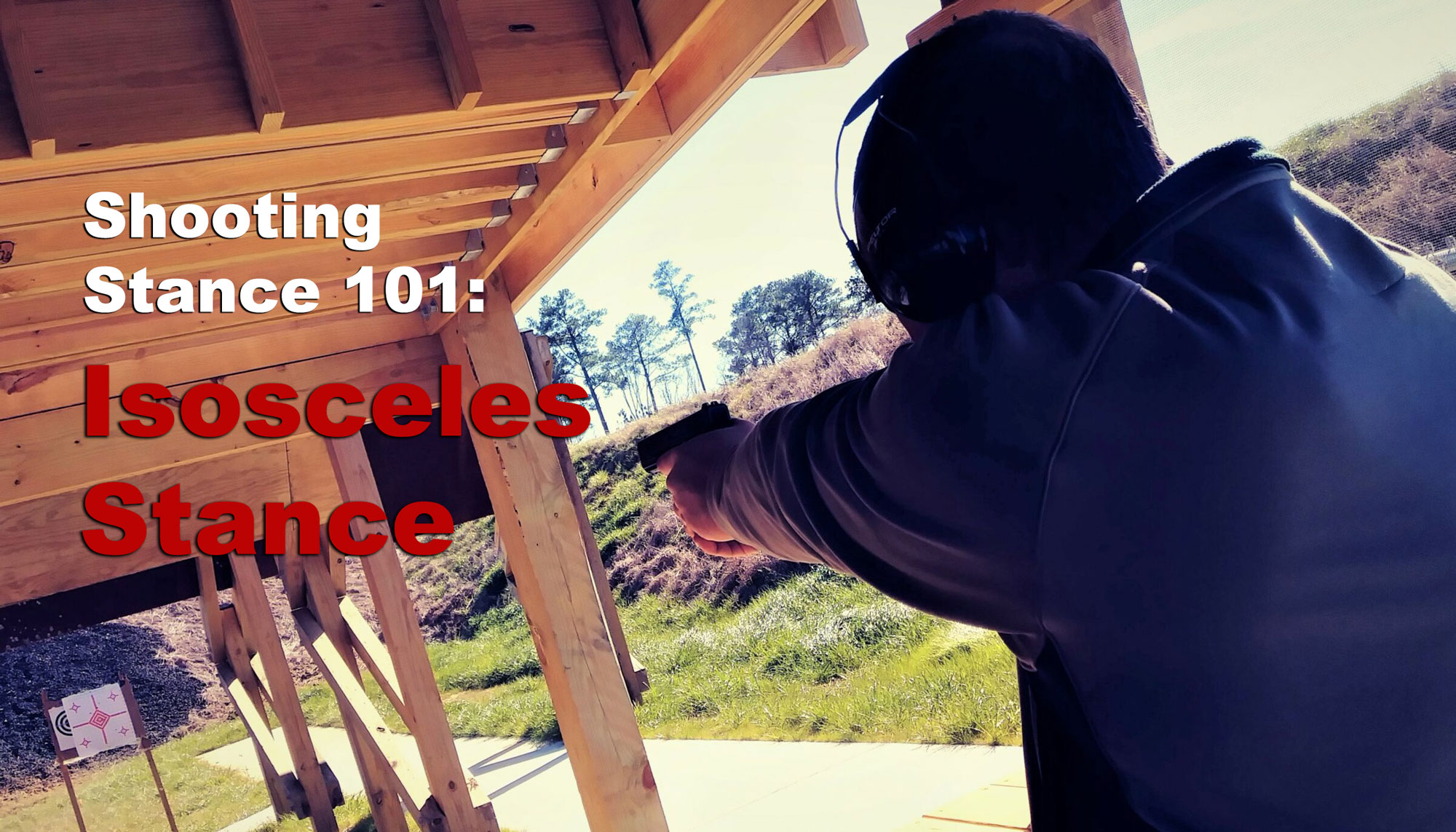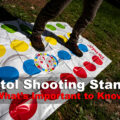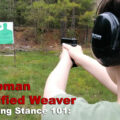What is the Isosceles Stance and what type of shooter should use it? Let’s explore this shooting style and see if there’s a way to add it to your toolbox on the firing line.
A proper shooting stance provides a strong foundation on which to build all the other shooting fundamentals. However, a solid stance won’t look exactly the same for every shooter. Body structure, shooting application, and even personal preferences can create seemingly endless variations in stance.
Fortunately, modern shooters can choose from a plethora of stance options. One of the most popular is the Isosceles stance. Drawing its name from one of Euclid’s triangles, the Isosceles stance has plenty of advantages. While there is no perfect, one-size-fits-all shooting stance, this one comes pretty close. Let’s take a closer look at this popular pistol shooting stance.
A Brief History of the Isosceles Stance
The exact origin of the Isosceles stance is hard to trace. It is a natural stance many new shooters instinctively assume when first handed a pistol. Because it is simple, instinctive, and so widely used, it is impossible to track the stance back to its first use.
We do know that the stance gained major popularity in the 1980s, when Brian Enos and Rob Leatham used it to win several International Practical Shooting Confederation (IPSC) competitions.
What is the Isosceles Stance?
When using a traditional Isosceles stance, the shooter faces the target squarely, with both feet parallel and hip-width apart, and the toes pointing toward the target. The non-dominant hand wraps around the support hand to hold the weapon. The arms are fully extended. Some shooters choose to lock the elbows. Others may keep a small amount of flex in the joints.
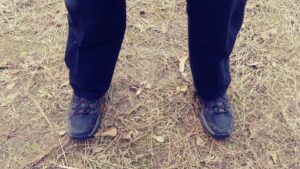
This arms extended position allows the shooter to keep the head upright while centering the handgun naturally with the eyes. This is a great option for cross-dominant shooters, because no major adjustments are needed to effectively line up the dominant eye with the weapon’s sights. This position also preserves peripheral vision, making the Isosceles stance well-suited for personal protection applications.
If you paid attention in high school geometry, you probably remember an isosceles triangle is a triangle with (at least) two equal sides. When the Isosceles shooting stance is viewed from above, there is an obvious triangle formed by the shooter’s arms and chest. With both arms locked, the triangle has two equal sides.
The Modern Isosceles Stance
Sometimes called the Power Isosceles, the Modern version of the classic Isosceles stance requires the shooter to lean forward slightly at the hips until the nose is just over the shooter’s toes.
The feet remain shoulder-width apart with the knees slightly bent. However, the dominant -side foot will step back slightly, leaving one foot forward of the other.
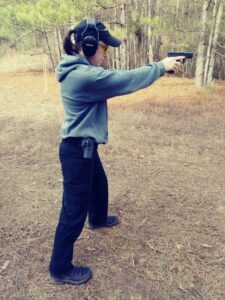
Although the changes are relatively minor, they shift the body’s center of mass forward, which helps improve recoil management.
Advantages of the Isosceles Stance
Although the Isosceles Stance has been around for some time, more and more modern shooters are choosing some variation as their go-to stance, and for good reason.
A Natural Stance
Perhaps the biggest advantage of the Isosceles stance is that it is a natural human posture. Even experienced shooters who have drilled some other standard shooting stance (usually the Weaver or Chapman) often revert instinctively to some version of the Isosceles in a high-stress situation.
The famous American firearms and self-defense instructor, Massad Ayoob, wrote about this inclination in 1984.
“The Weaver, for several reasons, tends to fall apart under extreme stress. While some people will fire better with one technique on the range, and some with another, we are finding that the straight-arms Isosceles position seems to work best under extreme stress.”
Ray Chapman, co-founder of the International Practical Shooting Confederation (IPSC), and the developer of the popular Chapman Stance agreed, referring to the Isosceles Stance as the “stress position.”
The upper body position of the stance also mimics the natural human startle response. If you spend any time on YouTube watching violent encounters, both civilian gun owners and officers respond to actual threats by punching their weapon out in front of them. It is an instinctive response to get a weapon between you and a perceived threat as quickly as possible.
The Isosceles Stance also builds on the shooter’s own inherent accuracy. Essentially, all the shooter must do is “point and shoot.” This works well for close-range violent encounters where precision aiming isn’t essential to getting rounds on target.
It doesn’t even matter which eye is dominant. With the firearm directly in front of the chest, the shooter can easily use either the right or left eye to aim.
Mobility
When assuming the Isosceles stance, both arms are equally engaged. This arm position along with the squared-up body position allows the torso to easily pivot, providing almost a full 180 degrees of mobility without ever having to move the feet. When engaging multiple targets, the ability to swivel becomes a major asset.
Perfect for Body Armor
For law enforcement officers (or anyone wearing protective gear), the squared position of the Isosceles stance places the shooter’s body armor directly in line with the target. This position maximizes the ability of the protective armor to stop incoming fire from a front-facing threat.
Recoil Control
The straight-arm position of the Isosceles stance allows the body’s bone structure to help absorb recoil. Because the shooter needs less muscle strength to manage recoil in this position, the Isosceles stance is ideal for smaller shooters with limited upper body strength.
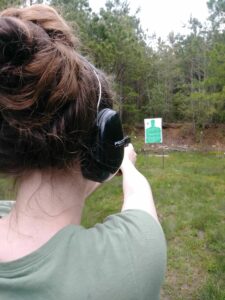
Balance
The parallel foot position of the traditional isosceles stance provides excellent side-to-side balance. However, the shooter is susceptible to being unbalanced from the front or back if someone pushes or pulls them. With weak front-to-back balance, the shooter may have stability issues during recoil, especially when shooting larger calibers or magnum loads.
The Modern Isosceles addresses the traditional stance’s balance issues by shifting the support foot slightly forward and bending the knees slightly. These two small adjustments help improve front-to-back balance. With better balance, shooters experience a dramatic improvement in recoil control. However, the slight forward lean can create a balance issue if the shooter is bumped from behind.
Disadvantages of the Isosceles Stance
While the squared position of the Isosceles stance is an advantage if you’re wearing body armor, it is a major disadvantage if you aren’t. Facing an assailant head-on provides a head-on threat with a wider target area, a major disadvantage in a gunfight.
Shooting from the Isosceles stance can also cost the shooter the ability to move easily from their shooting location. Although the torso can pivot to face multiple targets, the foot position can make movement difficult. Planting the feet parallel, shoulder width, and facing the target makes lateral motion more difficult. Self-defense situations are always dynamic, and getting to cover may be just as important as getting lead on target.
Summing It Up
Here is a recap of the pros and cons of the Isosceles stance.
The Pros:
- It is a natural shooting stance, especially for shooters in stressful situations.
- The stance uses the shooter’s innate “point-and-shoot” instinct.
- The shooter retains his or her peripheral vision.
- Cross-dominant shooters won’t have to struggle with awkward sight alignment.
- The body’s natural structure absorbs recoil.
- It is an ideal position for shooters wearing body armor and encountering a head-on threat.
- The shooter can easily pivot to engage multiple targets.
The Cons:
- The front-facing position creates a large target for a head-on threat.
- The foot parallel position makes the shooter’s front-to-back balance weak.
- Lateral motion is limited, making it difficult to move locations in a dynamic shooting situation.
No one stance is perfect for every situation. Many shooters find the Isosceles stance is easy to learn and makes shooting feel more natural. The fact that the stance is so simple is what ultimately makes it so effective. When the adrenaline starts pumping in a real-life self-defense situation, being able to fall into a shooting stance easily and naturally could save you precious seconds.
